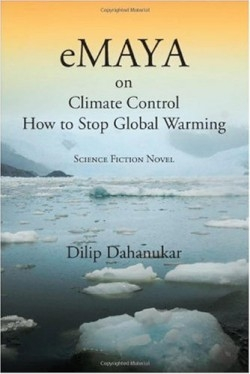eMaya on Climate Control
Although the opening of his book focuses on a human student Jerry Benson the main characters in Dilip Dahanukar’s novel eMaya on Climate Control are sentient computer programs. Bitsy an artificial intelligence created by Jerry and her friends Guhu (clearly based on Google) and Miki (short of Mikipedia) spend a brief but very dense thirteen chapters investigating the causes of and solutions to the anthropocentric rise of Earth’s temperature often referred to as global warming. They create an online persona eMaya and form a group of environmentalists “Friends of CoolWorld” to help them realize their plans which include seeding various bodies of water with duckweed to absorb carbon dioxide.
Topics covered here include the Kyoto Protocol nuclear power flaws in plans to slow warming by particulate seeding of the atmosphere agriculture carbon sequestration the impact of livestock biofuels terrorism commodity trading of foodstuffs and flaws in arguments against the existence of global warming. Each chapter ends with an email written by Bitsy’s persona eMaya summarizing the material covered and making suggestions for action (sometimes rather nebulous ones).
“I am concerned with the rising population of the World…” eMaya writes in one e-mail. “We need to check the growth of population of both humans and animals….We are growing at the rate of one billion people every 12 years….Will we have enough food for all? The answer is an emphatic NO….There is a bigger calamity ranging ahead of us than the global warming. Wake up my friends….We have to reduce the growth rate of our population and also our livestock. Think about it.”
Although Dahanukar occasionally seems to favor one approach over another he is generally uncritical of industrial (rather than social) solutions (except where consumption of animal products in concerned). At times it is difficult to discern his primary argument or stance vis-&224;-vis each concept despite the end of chapter summaries but it is clear that he believes nuclear power is acceptable and anthropocentric global warming exists and is a problem which must be addressed. Using a story as a platform to introduce concepts related to global warming is conceptually interesting but this attempt fails in execution.
Overall this reads less like the novel it purports to be than a slightly confusing rundown of concepts related to global warming and the characters themselves don’t have much individuality primarily functioning as mouthpieces for Dahanukar’s explanations and arguments. Although much of the material covered is interesting it feels unfiltered both in presentation and in organization. Grammatical errors and syntactical awkwardness don’t make the technical material any easier to follow.
Reviewed by
Val Grimm
Disclosure: This article is not an endorsement, but a review. The publisher of this book provided free copies of the book and paid a small fee to have their book reviewed by a professional reviewer. Foreword Reviews and Clarion Reviews make no guarantee that the publisher will receive a positive review. Foreword Magazine, Inc. is disclosing this in accordance with the Federal Trade Commission’s 16 CFR, Part 255.

